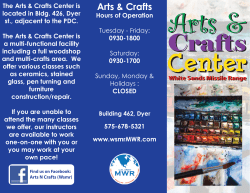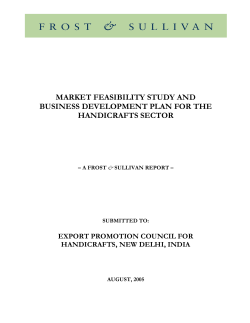
Document 119734
Review Article Vol 1 (2013) 30 - 32 (June –Dec 2013) Neheu E- Journal A Journal of Nehru Arts and Science College (NASC) Journal Home Page: http://nehrucolleges.net/jo.html ISSN: xxx xxxx xxxx xxxx Government Guidelines Towards Handicrafts Exports V.S.Karpagavalli Department of Costume Design & Fashion, Nehru Arts and Science College, Coimbatore th Received: 24 June 2013 th Accepted: 19 July 2013 th Available Online: 14 August 2013 Abstract Keywords: Handicraft, textiles labour, Indian Handicrafts, which constitutes a significant segment of the decentralized sector of the economy, its export has reached at a commendable height. Indian folk art and crafts which are the integral parts of the Indian culture and tradition are in high demand among the western countries. The biggest problem in the Indian Handicraft industry is that the village crafts men remain concerned that with free trade and mass production, hand-made products from other parts of the world will out price the products of their hard labour. With a brief theoretical understanding, this paper looks at government guidelines towards Indian handicrafts and exports. It tries to assess how far government exports serve an opportunity and welfare scheme to the artisans. The role of the government in promoting the crafts and protecting the artists will be discussed in this paper. Introduction Handicraft, also known as craft work or simply craft, is a type of work where useful and decorative devices are made completely by hand or using only simple tools. Usually the term is applied to traditional means of making goods. Usually, what distinguishes the term handicraft from the frequently used category arts and crafts is a matter of intent: handicraft items are intended to be used, worn, etc, having a purpose beyond simple decoration. Handicrafts are generally considered more traditional work, created as a necessary part of daily life, while arts and crafts implies more of a hobby pursuit and a demonstration/perfection of a creative technique. Indian Handicraft Items Metal craft, metal ornamentation, pottery and stone craft, stone craft and marble inlay work, terracota, wood craft, precious and semi precious stones, paintings, textiles, cane and mooonj, carpets and durries. Handicrafts Export Markets in India Labour-intensive in nature, the Indian Handicrafts and Gifts Industry is a major revenue generator of the country providing employment opportunities to more than 6 million craftsmen throughout India. Today it enjoys a strong presence in the world market with a turnover of USD 1.9 billion. It has also shown a consistent annual growth rate of more than 15 per cent over a period of 10 years, with a steep rise from a mere 3.6% to a 10% share in global handicraft exports. Major Indian states that contribute to exportation of various handicraft items are Andhra Pradesh, Uttar Pradesh, Rajasthan, and Gujarat. Moreover, popular handcrafted gift items manufactured and marketed from India includes vases, candle stands, Christmas ornaments, pen stands, brassware, papier mache gift items, ceramic pots and handmade paper products in matchless variety and designs. Export Promotion Council Export Promotion Council for Handicrafts (EPCH) under the aegis of Development Commissioner (Handicrafts), Ministry of Textiles, and Government of India is a non-profit organization, established under the EXIM policy of Government of India in the year 1986-87. It has created necessary infrastructure as well as marketing and information facilities, which are availed both by the member exporters and importers. The Council is engaged in promotion of handicrafts from India and project India’s image abroad as a reliable supplier of high quality handicrafts. Export Promotion Scheme for Handicrafts from EPCH To keep pace with the changed scenario in World Trade and in view of WTO regime, there is a need to bring changes in Handicrafts sector for exploring its export to compete in international markets, sustain livelihood of over four millions crafts persons involved in the sector as well as to keep revival and preservation of old tradition & heritage of Indian crafts. Schemes Product Development The design & technology aspects play a very important part in marketing the handicrafts and in *Corresponding Author Tel:91- 99522 63261 (V.S. Karpagavalli) E.Mail Addresss: nasccdf@gmail.com 30 Karpagavalli et al. 2013/ / Nehru E-Journal.1 (2013) 30 - 32 order to compete in the international market it is necessary to promote the organizations involved in export of handicrafts for development of new and innovative items. In order to meet out this requirement as per changing taste, fashion of the consumers in the foreign markets, it is proposed to provide financial assistance for development of exportable products, by way of selecting or involving reputed designers from India and abroad who will help them to develop the items/range of items as per requirement of foreign market which will enable the exporters to compete in the international market a) Workshop and Training Programme in Packaging and in Export b) Training of Artists/Master crafts persons/Designers c) Workshop/seminar in India and Abroad d) Selection of Designers, Artists for development of prototypes for exports and invitation to foreign Designers. PUBLICITY & MARKETING The organizations that are developing the new and innovative items are required to give publicity at the international level in order to explore the possibility to market their items. Effective and well designed publicity drive create awareness amongst the potential buyers as to the strength of the products ranges being offered by India and also help in dissemination of National policies and information on other issues like Social Environmental, working condition to educate buyers and consumers. It is, therefore, proposed to launch a systematic publicity campaign through audiovisual/ printed publicity by making video film preparing posters, catalogues, folders, brochures on Indian Handicraft/Carpet, Road Shows, Catalogue Shows, fashion shows, live demonstration by crafts persons and such other methods as will create positive image of Indian Handicrafts in the foreign markets. Schemes of the Office of Development Commissioner (Handicrafts), Ministry Of Textiles, Government of India The Office of Development Commissioner (Handicrafts) is responsible for formulation and implementation of several schemes for the development of handicrafts at the Central level. This office also provides necessary guidance to the State Government for formulation and implementation of their promotional programmes. A necessity, therefore, arises to have a regular system of feedback of economic, social, aesthetic and promotional aspects of various crafts and artisans in this sector. It also arranges promotional programmes for this purpose. Babasahib Ambedkar Hastshilp Vikas Yojana This scheme aims at promoting Indian handicrafts by developing artisan’s clusters into professionally managed and self-reliant community enterprises on the principles of effective member participation and mutual cooperation. This thrust of the scheme is on a projectile need based integrated approach for sustainable handicrafts development through participation of craftsperson leading to their empowerment. Bima Yojana for Handicrafts Artisans Objectives “Bima Yojana” for Handicraft Artisans is in operation since 2003-04 with the objective of providing life insurance Protection to Handicraft Artisans which has two components namely “Janshree Bima Yojana” & “Add-on Group Insurance Scheme” for male as well as female age group of 18 60 years. The scheme is being implemented through Life Insurance Corporation of India. Credit Guarantee Scheme The objective of the scheme is to alleviate the problems of collateral security or third party guarantee and remove implements to flow of credit in the handicraft sector. Training & Extension The main objective of this scheme is to enhance the capacity building artisans, NGO etc. and to meet the administrative expenditure of Carpet Weaving Training Centre in J&K and 23 cane & bamboo departmentally run training centers. Design & Technology Up gradation Design & Technology Up gradation scheme aims at up gradation of artisans skills, improvement and diversification of products, development of new design of prototypes, supply of improved/modern equipments to the craft persons, revival of rate crafts to preserve the traditional heritage, preservation of traditional art & crafts of high aesthetic value, etc. Marketing Support & Services The main objective of this scheme is to create awareness of Indian Handicrafts among the masses by organizing a number of marketing events in big and small cities, to provide financial assistance to state Handicrafts Development Corporations, Apex Cooperatives and prominent NGOs for opening new Emporia at suitable places to enable the craft persons to have permanent sales outlets for their products, to popularize and publicize handicrafts sector, to provide services in the form of entrepreneurship development programme etc. All India Handicrafts Board The All India Handicrafts Board was established in 1952 to advise the Government on problems of handicrafts and to suggest measures for improvement and development. The Board was also required to study technical, marketing, financial, organizational, artistic and other aspects of handicrafts and to formulate plans on these lines. The Handicrafts and Hand Looms Export Corporation Of India The Handicrafts and Hand looms Export Corporation of India, a popular organization of All India Handicrafts Board was established in 1962. This organization promotes exports and development of potential market execution of Whole Sale and retail Orders. 31 Nehru E – Journal – A Journal for Arts, Science and Humanitis Karpagavalli et al. 2013/ / Nehru E-Journal.1 (2013) 30 - 32 Comprehensive Handicrafts Cluster development Scheme – A Central Sector Scheme Keeping in view the fact that the export value realization of Handicrafts products is quite high, integrated infrastructure development has been the policy focus in recent times. The multiplicity in production in tiny units along with geographical wide spread base has resulted into higher level of levies marring the competitiveness in international market. Thus, addressing the problem of infrastructure bottlenecks by suggesting continuation of the sector specific infrastructure schemes has been the focus of attention. It is in this background it is proposed to launch a new Comprehensive Handicrafts Cluster Development scheme (CHCDS) - Growth foci for spatial development in rural mosaic towards spiral percolation through partnership. CONCLUSION The Government has created a macro economic framework over the last decade with the aim of stimulating and sustaining growth in the economy. Inflation has reduced to a single digit; the external sector has been liberalized with price deregulations and free transactions in foreign exchange. Government has also divested itself from economic activities thus ending State monopolies. However, the country still lacks a comprehensive trade policy, which specifies sector specific export strategies. While some economic policies have been designed specifically to suit promotion needs of the export sector, they largely address the needs of large business and industries and ignore the needs of small scale and medium business units in rural and urban areas. Various government policies programme and interventions in the export sector have largely disregarded the importance of handicrafts in rural livelihood especially of women. Reference 1. Export Promotion Council for Handicrafts 2. Government of India, Planning Commission, Plan Documents. 3. Indian Council for Research in International Economic Relations study. 1993. 4. UNESCO-UNCTAD/WTO (ITC) at Manila: 6 – 8 October 1997. 32 Nehru E – Journal – A Journal for Arts, Science and Humanitis
© Copyright 2025











